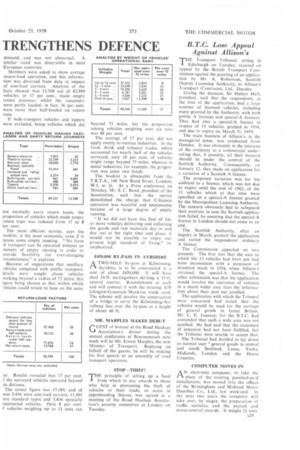NEW C-LICENCE SURVEY
Page 30

Page 31

If you've noticed an error in this article please click here to report it so we can fix it.
TRENGTHENS DEFENCE
Growth of Ancillary Fleets Reflects Higher Standard of Service to Customers
RESULTS of the survey of C-licence operations carried out by the Traders' Road Transport Association substantiate the arguments put forward in the defence of ancillary transport for many years. A booklet, "Survey of C-licensed Vehicles," containing 27 tables and other data, was published by the Association on Monday.
It gives four main reasons why the 4,837 members concerned in the survey ran their own vehicles. These were: speed and certainty of delivery; lower cost (although this was secondary to service); reduction in damage and pilferage; and need for less packaging and handling.
In the preamble to the 'statistics, it is stated in the booklet that it is no part of the Association's function to stimulate the use of C-licence vehicles, but there had been a lack of basic information about their work. The survey, covering 98,340 vehicles, was therefore undertaken. Operators were asked to complete questionnaire forms, and the facts returned were analysed and compiled by an independent agency, with a final check by a statistician.
The number of vehicles covered was 9 per cent. of the total of C-licence registrations at June 30, 1958, and made up as follows: up to 3 tons, 69.980; 3-5 tons, 16,677; over 5 tons, 11,683. In the last-mentioned category, the number of vehicles was 59 per cent. of the total registered.
Some 24 per cent, of the vehicles in the sample were non-load carriers—service and representatives' vans, for example—and bat tery-elect ries. Abo at 28 per cent, were specially fitted or constructed, partly because of the integration of transport into mechanicalhandling systems.
Growth of C-licence vehicles reflected the higher standard of service which traders wished to give and customers demand, and was not abnormal. A similar trend was discernible in most European countries.
Members were asked to show average return-load operation, and this information was divorced from data in respect of non-load carriers. Analysis of the facts showed that 13,768 out of 82,999 vehicles, or 17 per cent, made empty return journeys, whilst the remainder were partly loaded; in fact, 36 per cent. were more than half-loaded on return runs.
If bulk-transport vehicles and tippers were excluded, being vehicles which did
not normally carry return loads, the proportion of vehicles which made empty return trips was reduced from 17 to 8 per cent.
The most efficient service, says the looklet, is the most economic, even if it neans some empty running. "No form )f transport can be operated without an element of empty running in order to novide flexibility for ever-changing ircumstances." it explains.
Because of suggestions that ancillary 'chicks competed with public transport, Wails were sought about vehicles vorking beyond a radius of 75 miles, this igure being chosen as that within which chicks could return to base on the same ay. Results revealed that 17 per cent. f the surveyed vehicles operated beyond us distance.
The actual figure was 17,189, and of lese 3,436 were non-load carriers, 11.303 'ere standard types and 3,436 specially onstructed vehicles. Only 8 per cent. f vehicles weighing up to I+ tons ran beyond 75 miles, but the proportion among vehicles weighing over six tons was 48 per cent.
The average of 17 per cent. did not apply evenly to various industries. In the food, drink and tobacco trades, which accounted for nearly half of the vehicles surveyed, only 10 per cent. of vehicles might range beyond 75 miles, whereas in metal industries, for example, the proportion was some two thirds.
The booklet is obtainable from the T.R.T.A.. 146 New Bond Street, London, W.1, at 2s. At a Press conference on Monday, Mr. S. C. Bond, president of the Association, said that the survey demolished the charge that C-licence operation was wasteful and uneconomic because of a large degree of empty running.
"If we did not have this fleet of lm. or more vehicles delivering and collecting the goods and raw materials day in and day out at the right time and place, it would not be possible to enjoy our present high standard of living." he emphasized.
£450,000 BY-PASS IN AYRSHIRE
ATWO-MILE by-pass at Kilwinning. Ayrshire, is to be constructed at a cost of about £450,000. It will have dual 24-ft. carriageways skirting a 15-ft. central reserve. Roundabouts at each end will connect it with the existing A78 Glasgow-Greenock-Monkton trunk road. The scheme will involve the construction of a bridge to carry the Kilwinning-Ayr railway line over the by-pass at a height of about 40 ft.
MR. MARPLES MAKES DEBUT
r_UEST of honour at the Road Haulage
Association's dinner during the annual conference at Bournemouth next week will be Mr. Ernest Marples, the new Minister of Transport. Replying on behalf of the guests, he will be making his first speech to an assembly of road transport operators.
STOP-THIEF!
THE principle of setting up a fund from which to pay awards to those who help in preventing the theft of vehicles or their loads, or assist in apprehending thieves, was agreed at a meeting of the Road Haulage Association's security committee in London on Tuesday.




































































































